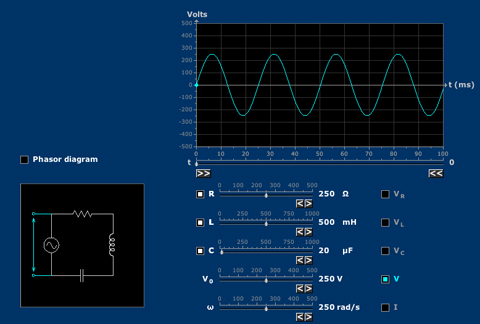Series RLC Circuit
System responses of a sinusoidally driven RLC circuit can be understood by means of phasors.
 System responses of a sinusoidally driven RLC circuit can be understood by means of phasors.
System responses of a sinusoidally driven RLC circuit can be understood by means of phasors.
9 Responses to “Series RLC Circuit”

I love it. I wish we had this in my EE years in mid-seventies.
Good job, well done, what a great service you provide for free.
Best,
Mori Mirashrafi
I see why the OCW Scholar Diff.Eq. course heaps so much praise on this mathlet. It's utterly excellent. My only negative thought is that as a person learning this stuff, I missed having the impedance visualized somewhere. Trying to explain to myself how everything fit together, i definitely feel I needed to see it alongside the phasors.
This mathlet made everything orders of magnitude easier to grasp, making the whole thing tangible. Whoever made it, I greatly appreciate the time and effort you spent.
Thank you for this comment, K. I agree. The "impedence" or "complex gain" for systems of this type is displayed in the "Amplitude and Phase" series of Mathlets. There just wasn't room on "Series RLC Circuit" for that representation! We built this one in collaboration with the MIT physics department, for use at a particular moment in their E&M course.
Is there any way to change the maximum values of R L C?
Marcelo - We tried to offer a reasonably realistic range of values for R, L, C. If you have other applications, it would be interesting to hear them. You can change the voltage amplitude.
I am a contract instructor of would-be future electricians at a small rural college campus. To try to bring home the relationship of time-domain sine waves to phasor diagrams and make some of this (to my students) abstract stuff come to life, I purchased a USB 'scope, and brought in my function generator and some components so that I could do live demonstrations.
This applet far exceeds the capabilities of my setup to pull all these ideas together, and the fact that I can send my students to the site to play with it themselves is absolutely priceless.
I must say the triggering on your "scope" is a lot more stable than mine too...
Thank you for making these wonderful applets available for us!
They are easy to use, and they are valuable resources for understanding complex concepts that students often struggle with. Our students greatly benefit from them. Thank you!
That's great to hear, Scott! But don't underestimate the power of an actual artifact!
That's so good to hear, Jay! It would be great to hear how you use them for the benefit of your students.